Abstract
Energy balance closure is an important feature in studies of ecosystem exchanges of energy and greenhouse gases using the eddy covariance method. Previous analyses show that this is still a problem with imbalances in the order of 0.6–0.7 to full closure (for only a few sites). It has been suggested that mesoscale transport processes that are not captured by the eddy covariance measurements are the main reason behind the closure problem. So far, very little action has been taken to investigate another potential cause of the problem, namely, the role of spatial variation in net radiation at the scale of typical flux footprints. The reason for this knowledge gap is mainly due to the lack of suitable methods to perform such investigations. Here, we show that such measurements can be performed with an unmanned aerial vehicle equipped with radiation sensors. A comparison using a reference radiometer on a fixed mast with a hovering UAV equipped with pyranometers for incoming and outgoing shortwave radiation and an infrared thermometer for surface temperature measurements shows that incoming and outgoing shortwave radiation can be measured with a standard error of 7.4 Wm−2 and 1.8 Wm−2, respectively. An application of the system was made over a five-year-old forest flux site in Sweden. Here, the net longwave radiation was estimated from the measured surface temperature and the calculated incoming longwave radiation. The results show that during the mission around noon on a clear day, distinct ‘hotspots’ existed over the plantation with the albedo varying between 15.5 and 17.9%, the surface temperature varying between 22.2 and 25.5 °C and the net radiation varying between 330 and 380 Wm−2. These variations are large enough to have a significant impact on the energy balance closure problem. Our conclusion is that we now have the tools to investigate the spatial variability of the radiation regime over flux sites and that this should be given more attention in the future.
1. Introduction
The determination of vegetation surface energy exchange is an important component in most studies aiming to understand how ecosystems interact with the atmosphere and the climate system [1]. The convective energy fluxes are typically measured using eddy covariance, ground heat fluxes are measured using flux plates or a combination of temperature and moisture sensors, canopy storage is measured using temperature sensors and radiation fluxes are measured using short- and longwave sensors, e.g., [2]. Ideally, the sum of the convective energy fluxes, the ground heat flux and the canopy heat storage should equal the net radiation flux on top of the canopy so-called energy balance closure, but this situation is rarely met, and most flux sites underestimate the energy balance, e.g., [3]. The problem of the lack of energy balance closure at flux sites has been discussed for a long time, pointing mainly at the errors in the eddy covariance measurements [4] as well as in the net radiation measurements [5].
Foken [6] made a thorough review of the energy balance closure problem and he hypothesized that it was most likely related to large scale eddies that were not captured in the eddy covariance measurements, and that the problem could only be solved at the landscape level. In a later follow-up review of the problem, Mauder et al. [7] ruled out instrumental errors as the cause and came to the same conclusion as Foken [6] did, namely, that it is mesoscale transport issues that are responsible for the non-closure. However, Mauder et al. [7] never discussed the potential error in the net radiation measurements caused by spatial variability. The radiation components in flux studies are typically measured at one point in space with the instruments mounted on the same tower as the eddy covariance instruments. However homogeneous a flux site may be, the location of the tower is always disturbed to some degree, and this might bias the especially outgoing radiation fluxes and thus, also the net radiation.
The largest variation of outgoing short- and longwave radiation can probably be expected in sparsely vegetated ecosystems with a low fractional canopy cover where upwelling radiation from the soil can penetrate the atmosphere above the ecosystem. However, dense tree canopies consisting of species mixtures, especially mixtures of conifers and deciduous trees, can presumably also show a large variation in reflectance properties. An example of the former case was shown by Anthoni et al. [8], which analyzed the variation in the net radiation in a juniper–sagebrush ecosystem. They measured the shortwave reflectance and the surface temperature of the soil at different locations within the footprint of a flux tower and used geometrical models of the canopy to estimate how much of the upwelling short- and longwave radiation would reach the net radiometers placed at random locations above the canopy. They found a spatial variability in the longwave upwelling radiation of 20 Wm−2, and 10 Wm−2 in the shortwave radiation. They concluded that such a variation was too small to explain the lack of energy balance closure which was in the order of 200–250 Wm−2 in their flux measurements.
From a practical perspective, the vegetation height is a strong constraint on the kind of method that can be used to measure the spatial variation of the radiation above ecosystems. Although the trees in the juniper–sagebrush study by Anthoni et al. [8] had a relatively modest height of about 7 m, they chose to make ground-based measurements which required quite complex geometric calculations to obtain the surface values of the upper canopy. Droppo and Hamilton [9] measured the vertical profiles of the net radiation within and above an 18 m high mixed deciduous stand, which they characterized as “relatively uniform” using three towers located in a triangular pattern about 15 m apart. They found a variation in the net radiation above the canopy in the order of 10–13% over midday which corresponds to 40–50 Wm−2 during clear sky conditions. Federer [10] measured the net radiation above a mixed deciduous (hardwood) canopy using six towers about 15 m apart and he found a range of about 20 Wm−2 during clear sky conditions, but on some occasions, the range could be up to 50 Wm−2.
Remote sensing methods have also been used, but mainly for analyses at larger scales; Fausto et al. [11] used Landsat TM5 (30 m resolution) to analyze the spatial variation of the net radiation in a heterogeneous savanna landscape in Paraguay, Bisht et al. [12] used Terra-Modis (km resolution) for analyses of the Southern Great Plains in the US and Wang et al. [13] also used Terra-Modis to estimate and compare the net radiation with the ground measurements of the Surface Radiation Budget Network [14]. Neither of these methods have sufficient resolution to assess the spatial variation of the net radiation with the footprints of eddy covariance flux sites.
A new era of detailed reflectance measurements at patch, ecosystem or even landscape scale has emerged with the rapid development of unmanned aerial vehicles (UAVs), carrying cameras for imagine analyses, e.g., [15,16] or radiation sensors for the direct measurement of reflectance, e.g., [17]. In the latter case, the incoming radiation had to be measured at some reference location near the flight path in order to obtain the albedo. Most studies use helicopter types of UAVs because of the time response of the sensors which might require that the measurements are recorded during hovering. More recently, fixed-wing UAV systems for complete eddy covariance measurements also including radiation balance have been developed [18].
The aim of this study is to develop a UAV surface radiation balance system that can be used to independently measure georeferenced incoming and outgoing shortwave radiation, net radiation and surface temperature for the spatial analyses of different ecosystems. Commercial radiation sensors and an infrared thermometer were mounted on a quadcopter equipped with a specially built data logger. The radiation sensors were compared to a reference four-component radiometer while attached to the same fixed mast, then also compared to the same reference when attached to the UAV under hovering conditions. Finally, an application study was performed at a five-year-old forest plantation where eddy covariance flux measurements are performed.
2. Material and Methods
2.1. Instrumentation and Measurements
The UAV used in this study is a quadcopter Matrice 200 v2 (DJI, Shenzhen, China) that has a maximum payload of 1.45 kg. A specially designed rig was built to hold the downward-looking shortwave radiation sensor, the net radiation sensor, the infrared thermometer and the external GPS antenna of the data logger (see Figure 1). The upward-looking shortwave radiation sensor was mounted on a flat surface on top of the UAV and the data logger was mounted where the camera was normally located (Figure 1). The sensor specifications are presented in Table 1. The net radiometer designed by J.M. Reemann, Tartu, Estonia consists of a small cylinder 19 mm in diameter and 19 mm in length, supported with a 50 mm horizontal arm. The radiation receiving upper and lower surfaces consists of black-coated cavities shaped to give correct cosine response. The cavities do not have any protection against wind or rain.
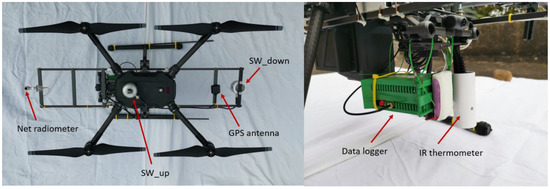
Figure 1.
(Left): UAV from above with mounted sensor rig. (Right): data logger and IR thermometer with radiation shield.

Table 1.
Specifications for UAV sensors. Sensitivity was given by manufacturer except for the net radiometer which was calibrated against the four-component reference instrument. SWin is incoming shortwave radiation and SWout is outgoing shortwave radiation. More details can be found in Supplementary Materials.
The downward-looking shortwave sensor and the net radiometer were carefully adjusted to be located in the same plane as the upward-looking shortwave sensor. Then, the UAV was calibrated for center of gravity, and after calibration and during hovering, it was visually checked that the upward-looking shortwave sensor was in a horizontal position. Since no inclinometer was available, we had to assume that all sensors were in a horizontal position during hovering. This assumption was tested by orienting the UAV in different directions during the inter-comparison campaign (see below).
The lightweight data logger was specially built for this purpose (EMS, Brno, Czech Republic). It has two channels reserved for the IR thermometer and four differential channels ± 40 mV. It is powered with a 2.1 Ah Li-Ion battery, and it has a continuous operational period of 30 h. The accuracy of the voltage measurements is ±0.15% of full scale. It has a built-in GPS (GPS + GLONASS) that provides date, time (UTC), latitude and longitude. The accuracy of the positioning system GPS + GLONASS is approx. 2–3 m which we consider sufficient for the type of mapping made here. The sampling interval is 2 s and the data are stored on a 16 GB microSD card. More information about data logger and radiation sensors is found in the Supplementary Materials.
The comparison between the UAV sensors and a recently factory-calibrated reference four-component net radiometer, CNR4 (Kipp&Zonen, Delft, The Netherlands), was performed on an open field over a recently cut fallow near Hjärup, Sweden 6–12 August 2022. The shortwave sensors on the UAV were new from factory, and thus, factory-calibrated before use in the field. The CNR4 was logged using a CR1000X (Campbell Scientific, Logan, UT, USA) with a sampling frequency of 1 s and the UAV sensors were recorded with the UAV logger with a sampling frequency of 2 s. The CNR4 was mounted on a tripod crossarm with a height of 2 m above ground together with the UAV radiation rig (Figure 2).
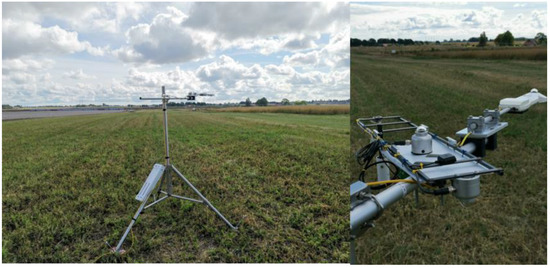
Figure 2.
The set up for comparison of shortwave sensors and for calibration of the UAV net radiometer. (Left): tripod with horizontal boom for radiation sensors. (Right): radiation boom with UAV radiation rig nearest and CNR4 at the end of the boom.
In the next step, the radiation rig was mounted on the UAV and a number of comparisons were made with the UAV hovering at the same height as the CNR4 and with a 1–2 m horizontal separation (Figure 3).
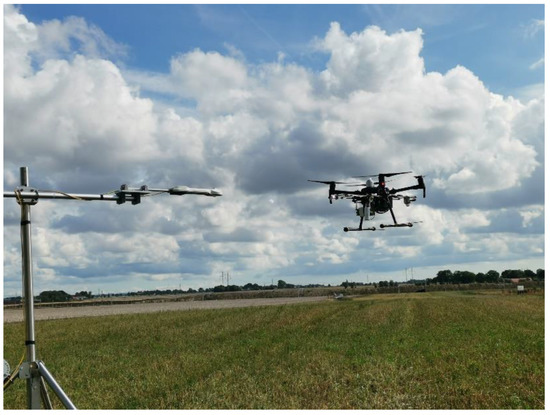
Figure 3.
The tripod with reference four-component radiometer (CNR4) and the hovering UAV equipped with radiation sensors.
After positioning the UAV beside the reference instrument, the measurements were made with the UAV heading south for 1 min, then the UAV was rotated 180° for another measurement period of 1 min. This was repeated 3 times during each measurement occasion, which took place once per hour from 09:00 to 14:00 UTC, resulting in a total of 38 comparisons. During one measurement occasion, the net radiometer was pointing east/west in addition to the south/north directions. This rotation of the UAV in different directions was made to check for the possible impact of deviations from the horizontal plane on the radiation measurements. The wind speed ranged between 3.4 and 5.2 m s−1 during these measurements.
The application study took place on a five-year-old forest stand near the Hyltemossa ICOS station during noon 14 August 2020. The site was clear-cut in December 2013 and planted with Norway spruce in 2014. The eddy covariance flux tower was established in April 2015. The average tree height was about 1.8 m when the UAV mission took place. Before the mission, the geographic positions of some few remaining and standing dead trees were determined in order to avoid those during the flight. The flight was planned, and the mission was performed using the UgCS software [19]. Eighteen waypoints (Figure 4) were selected for the measurements which were made during 2 min at each waypoint with the UAV hovering at a 10 m height above ground. The UAV was always oriented in the same direction during the measurement at each waypoint, and since it was hovering, it was kept in a horizontal position.
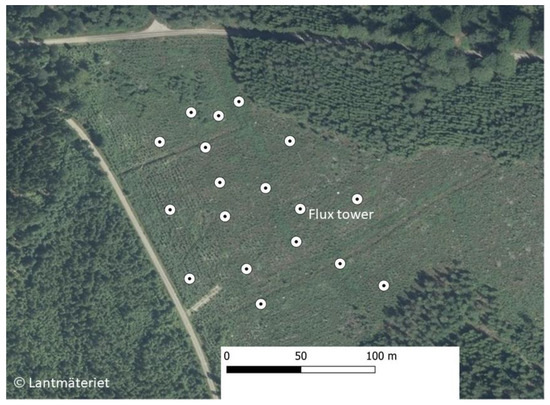
Figure 4.
Location of waypoints and flux tower at Hyltemossa young forest site. Aerial photograph August 2020.
2.2. Data Analyses
Before the measurements started, the clocks of both data loggers were synchronized. During the first part of the comparison, when the UAV radiation sensors were in a fixed position near the reference sensor, 10 min mean values were calculated for regression analyses. During the second part of the comparison, the last 20 s of each minute were used to calculate the mean values from the reference and the UAV sensors. This was carried out in order to allow the UAV sensors to adapt to new conditions after a 180° rotation.
During the application study at the young forest site, the last 10 s of each 2 min hovering period were used for the estimation of mean values. The reason for using only the last 10 s was to make sure that the sensors had adapted to the new conditions after moving from one waypoint to another. The following parameters were then calculated from the UAV sensors:
where α is albedo (%), SWout is outgoing shortwave radiation (Wm−2) and SWin is incoming shortwave radiation (Wm−2). The net radiation was calculated as:
where LWin and LWout are incoming and outgoing longwave radiation (Wm−2), respectively. LWin was calculated as:
where Ta is air temperature (K) and ε is atmospheric clear sky emissivity calculated as [20]:
where ea is vapor pressure (hPa). Ta and ea were obtained from the flux station. LWout was calculated as:
where Tsk is surface temperature (K) from IR thermometer. The mission was performed over midday with the aim of having the conditions as constant as possible. However, the weather data from the flux station showed that the net radiation increased by 0.17 W m−2 min−1 and the air temperature increased by 0.023 °C min−1 during the time of the flight. Therefore, the UAV-estimated net radiation and surface temperature were detrended using this information. Such detrending was not necessary for the estimation of albedo since albedo is a biophysical property of the surface. The wind speed ranged between 2.5 and 2.9 m s−1 during the mission.
All statistical analyses and plots were made with SigmaPlot 12.5 Systat Software Inc., San Jose, CA, USA). An inverse distance interpolation method was used to produce the filled contour plots (see below).
3. Results
3.1. Radiometer Comparisons
The recently calibrated four-component radiometer was used as a reference for the comparison with the UAV sensors when the UAV sensors were attached to the tripod and located near the CNR4 (Figure 2). The result of the linear regressions for shortwave sensors with the reference instrument as an independent variable and the result of the calibration of the UAV net radiometer are shown in Table 2. The weather was dry but quite windy with the highest wind speed varying between 2.3 and 9.7 ms−1 and with variable cloudiness during the comparison period. The incoming shortwave radiation ranged between 0 and 700 Wm−2 and the net radiation ranged between −80 and 450 Wm−2. We did not adjust the UAV sensors as a result of the intercomparison since there are uncertainties in the respective factory calibrations of both the CNR4 and of the UAV sensors.

Table 2.
Summary of the linear regressions during comparison with all sensors mounted on tripods close to each other. Fifty 10 min mean values were available for the analyses. S.E. is standard error of the regression.
The second part of the comparison with the instruments on the hovering UAV had similar weather as during the ‘fixed’ sensor comparison, except it was a little less windy with the highest wind speeds ranging from 3.4 to 5.2 ms−1. The wind direction turned from about 300 to 200 degrees during the measurements.
The results for the shortwave comparison were similar to the fixed sensor comparison with similar regression (Figure 5) and S.E. results for SWin (7.43 Wm−2) and SWout (1.81 Wm−2). The upward-looking sensor (SWin) had a tendency to show lower values when the UAV was pointing south as compared to when the UAV was pointing north (Figure 5 left). This difference was not seen in the downward-looking sensor (Figure 5 right). Since we did not have any inclinometer connected to the data logger, we could not make corrections for the deviations from the horizontal plane that occurred during hovering. However, we considered this to have a minor impact on the measurements since the wind speed was lower during the mission as compared to the intercomparison campaign.
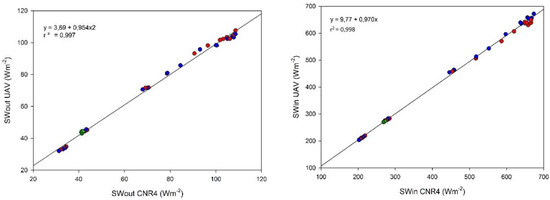
Figure 5.
Linear regression of SWin (left) and SWout (right) during hovering comparison with fixed CNR4. The different colors of data points represent different directions of the UAV; red with front sensor (Rn) pointing south, blue pointing north, light green pointing west and dark green pointing east.
The comparison for the net radiation sensor was not as good as during the fixed sensor comparison (Figure 6). In this case, there was also a similar tendency related to which direction the UAV was pointing, but the difference between the UAV Rn sensor and the reference CNR4 was much larger with an S.E. of 39.3 Wm−2. The reason for this is probably because the net radiometer is constructed without any wind protective cover. However, during the calibration when the UAV net radiometer was fixed close to the reference, we did not find any dependence on the wind speed, perhaps because the horizontal wind component dominates, and the wind probably does not penetrate down into the cavities which are the surfaces that absorb the radiation. When mounted on the UAV, the wind hitting the sensor is much more irregular due to the downwards wind field created by the hovering UAV, and that could explain the larger scatter (Figure 6).

Figure 6.
The regression result of the net radiation comparison. Same color code as in Figure 5.
3.2. Application over the Young Forest Site
The weather was fine with a low wind speed (approx. 2.5 ms−1) and a perfectly clear sky during the whole mission, which lasted about 50 min (two flights) over midday on the selected day. The incoming shortwave radiation was about 530 Wm−2 during the mission. The albedo ranged between 15.3 and 17.9%, with the flux tower in the middle of this range with a value of 16.2% (Figure 7). Flux footprints to the north would see lower albedo, while footprints to the south would see higher albedo.

Figure 7.
The variation in albedo over the young forest area. The position of the measurements is shown with the white symbols.
The measured surface temperature ranged between 22.9 and 27.6 °C, which corresponds to a range of 427–455 Wm−2 in outgoing longwave radiation. The detrended surface temperature showed a slightly smaller range with 22.2–25.5 °C (Figure 8). The ‘hotspot’ to the south of the flux tower has a similar location to the ‘hotspot’ in albedo (Figure 7). The flux tower seems to be located on the edge of a cold area which extends somewhat north.
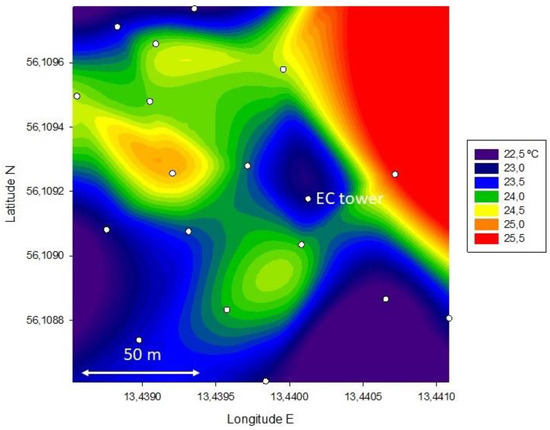
Figure 8.
The variation in surface temperature over the young forest area. The position of the measurements is shown with the white symbols.
Because of the poor results for the UAV-mounted net radiometer, it was decided not to use the directly measured values for the analyses of variability in the net radiation. Instead, the calculated values as described above (Equations (2)–(5)) were used. The detrended net radiation range was 330–380 Wm−2, which resulted in the spatial differences shown in Figure 9.
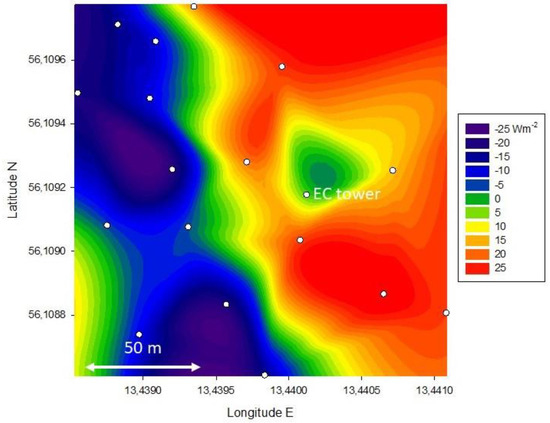
Figure 9.
Difference in net radiation over the young forest area. The position of the measurements is shown with the white symbols.
4. Discussion
Our comparison between a fixed radiometer and the radiometers mounted on a hovering UAV provided satisfactory results concerning incoming and outgoing shortwave radiation. The results concerning the net radiometer were not satisfactory and the instrument either needs to be modified or another type of net radiometer should be used. However, the measurement of the surface temperature using an infrared thermometer, together with the air temperature and the relative humidity from a weather station, made it possible to calculate the net longwave radiation. We consider this calculation to be accurate enough since the measurements were taken at noon during clear sky conditions and, thus, with only small changes in the incoming longwave radiation.
The measured albedo with a range of 15.3–17.9% is high compared to what closed mature coniferous forests typically show with values around 10%, e.g., [20]. The reason for the higher albedo is because after a clear-cut, there is normally an abundance of forest floor vegetation consisting of grasses and bushes which dominate the cover during the first years after plantation, and such species have much higher albedo than conifers. We can expect that the variation in albedo will diminish with time as the canopy closes more and more.
The surface temperature also showed quite a large variation, most likely because of the variation in the canopy coverage and shading of the soil, and because of the variation in soil moisture. Since outgoing longwave radiation is proportional to the fourth power of absolute temperature, this has a direct impact on the variation in the net radiation, which had a span of 50 Wm−2. This is similar to the variation in the net radiation reported by Droppo and Hamilton [9] and Federer [10] for deciduous stands.
Stoy et al. [21] analyzed the energy balance closure of 173 Fluxnet sites and they found a mean closure of 0.84 ± 0.20 for all sites. The best closure was found in the evergreen broadleaf forests with 0.94 ± 0.16, and the worst was found in the crops and wetlands with a closure of about 0.76–0.78. The evergreen needleleaf forests had an average closure of 0.88 ± 0.23. An imbalance of 10–15% would, in our case, correspond to an energy deficit of 35–53 Wm−2, which could be explained by the observed spatial variability of the net radiation (see Figure 9) depending on the location of the flux footprint. Stoy et al. [21] did not find a single factor that could explain the imbalances, but they suggested that future research should focus on the link between energy balance closure and landscape heterogeneity in addition to the consequences of mesoscale flow patterns for surface exchange processes. Our results indicate that heterogeneity on a local scale is also of considerable importance.
5. Conclusions
With the current set up of the UAV radiation sensors, we can conclude that we did not meet the aim of developing a fully independent surface radiation balance system in all its components since the used net radiometer was not suitable for this application. However, we have shown that incoming and outgoing shortwave radiation can be measured using pyranometers with a high accuracy, which can then provide spatial measurements of albedo on a scale relevant for flux footprints. With the aid of supplementary measurements of the air temperature and the relative humidity from a weather station, we were also able to estimate the spatial variation of the net radiation. For this particular application, a five-year-old plantation after a clear-cut, we can conclude that the spatial variation in the net radiation was of such magnitude that it could potentially explain a significant amount of energy imbalance.
A drawback of using thermal sensors is that the measurements take a relatively long time, since time for sensor adjustment must be allowed at each waypoint. This issue is not critical for the measurement of albedo since this is an inherent property of the vegetation, and because the changes in the sun elevation have little impact on the results, at least for elevations > 20° [22]. In the future, we believe that fast multispectral sensors can be used instead, providing much faster surveys. Finally, we recommend that the spatial variability of the radiation regime over flux sites should be given greater attention in the future.
Supplementary Materials
The following supporting information can be downloaded at: https://www.mdpi.com/article/10.3390/drones7040276/s1, Data logging system and short-wave radiation sensor specifications.
Funding
This research received no external funding.
Institutional Review Board Statement
Not applicable.
Informed Consent Statement
Not applicable.
Data Availability Statement
Not applicable.
Acknowledgments
This research did not receive any specific grants from funding agencies in the public, commercial, or not-for-profit sectors. Thanks to Tobias Biermann and Patrik Vestin for assistance during the preparation of measurements, with flight mission and for providing information about the application site. Thanks to Per-Ola Olsson for help with aerial photographs. Thanks also to Andres Kuusk who provided the Reemann net radiometer, and to Jiri Kucera, EMS, Brno for designing and building the data logger.
Conflicts of Interest
The authors declare no conflict of interest.
References
- Duveiller, G.; Hooker, J.; Cescatti, A. The mark of vegetation change on Earth’s surface energy balance. Nat. Commun. 2018, 9, 679. [Google Scholar] [CrossRef] [PubMed]
- Aubinet, M.; Vesala, T.; Papale, D. Eddy Covariance. In A Practical Guide to Measurement and Data Analysis; Springer: Dordrecht, The Netherlands, 2012; 451p. [Google Scholar] [CrossRef]
- Wilson, K.; Goldstein, A.; Falge, E.; Aubinet, M.; Baldocchi, D.; Berbigier, P.; Bernhoferf, C.; Ceulemans, R.; Dolman, H.; Field, C.; et al. Energy balance closure at FLUXNET sites. Agric. For. Meteorol. 2002, 113, 223–243. [Google Scholar] [CrossRef]
- Baldocchi, D.D. Assessing the eddy covariance technique for evaluating carbon dioxide exchange rates of ecosystems: Past, present and future. Glob. Chang. Biol. 2003, 9, 479–492. [Google Scholar] [CrossRef]
- Halldin, S.; Lindroth, A. Errors in net radiometry: Comparison and evaluation of six radiometer designs. J. Atmos. Ocean. Technol. 1991, 9, 762–783. [Google Scholar] [CrossRef]
- Foken, T. The energy balance closure problem: An overview. Ecol. Appl. 2008, 18, 1351–1367. [Google Scholar] [CrossRef] [PubMed]
- Mauder, M.; Foken, T.; Cuxart, J. Surface-Energy-Balance Closure over Land: A Review. Bound.-Layer Meteorol. 2020, 177, 395–426. [Google Scholar] [CrossRef]
- Anthoni, P.M.; Law, B.E.; Unsworth, M.H.; Vong, R.J. Variation of net radiation over heterogeneous surfaces: Measurements and simulation in a juniper–sagebrush ecosystem. Agric. For. Meteorol. 2000, 102, 275–286. [Google Scholar] [CrossRef]
- Droppo, J.G.; Hamilton, H.L. Experimental variability in the determination of the energy balance in a deciduous forest. J. Appl. Meteorol. 1973, 12, 781–791. [Google Scholar] [CrossRef]
- Federer, C.A. Spatial Variation of Net Radiation, Albedo and Surface Temperature of Forests. J. Appl. Meteorol. 1968, 7, 789–795. [Google Scholar] [CrossRef]
- Fausto, M.A.; Machado, N.G.; Nogueira, J.S.; Biudes, M.S. Net radiation estimated by remote sensing in Cerrado areas in the Upper Paraguay River Basin. J. Appl. Remote Sens. 2014, 8, 083541-1–083541-17. [Google Scholar] [CrossRef]
- Bisht, G.; Venturini, V.; Islama, S.; Jiang, L. Estimation of the net radiation using MODIS (Moderate Resolution Imaging Spectroradiometer) data for clear sky days. Remote Sens. Environ. 2005, 97, 52–67. [Google Scholar] [CrossRef]
- Wang, W.; Liang, S. Estimation of high-spatial resolution clear-sky longwave downward and net radiation over land surfaces from MODIS data. Remote Sens. Environ. 2009, 113, 745–754. [Google Scholar] [CrossRef]
- Augustine, J.A.; DeLuisi, J.J.; Long, C.N. SURFRAD—A National Surface Radiation Budget Network for Atmospheric Research. Bull. Am. Meteorol. Soc. 2000, 81, 2341–2357. [Google Scholar] [CrossRef]
- Cao, C.; Lee, X.; Muhlhausen, J.; Bonneau, L.; Xu, J. Measuring Landscape Albedo Using Unmanned Aerial Vehicles. Remote Sens. 2018, 10, 1812. [Google Scholar] [CrossRef]
- Canisius, F.; Wang, S.; Croft, H.; Leblanc, S.G.; Russell, H.A.J.; Chen, J.; Wang, R. A UAV-Based Sensor System for Measuring Land Surface Albedo: Tested over a Boreal Peatland Ecosystem. Drones 2019, 3, 27. [Google Scholar] [CrossRef]
- Levy, C.R.; Burakowski, E.; Richardson, A.D. Novel Measurements of Fine-Scale Albedo: Using a Commercial Quadcopter to Measure Radiation Fluxes. Remote Sens. 2018, 10, 1303. [Google Scholar] [CrossRef]
- Sun, Y.; Ma, J.; Sude, B.; Lin, X.; Shang, H.; Geng, B.; Diao, Z.; Du, J.; Quan, Z. A UAV-Based Eddy Covariance System for Measurement of Mass and Energy Exchange of the Ecosystem: Preliminary Results. Sensors 2021, 21, 403. [Google Scholar] [CrossRef] [PubMed]
- SPH Engineering. UgCS Desktop Application, Version 3.6.248; User Manual; 88 pages; SPH Engineering: Riga, Latvia, 2020. [Google Scholar]
- Idso, S.B. A set of equations for full spectrum and 8- to 14-µm and 10.5- to 12.5-µm thermal radiation from cloudless skies. Water Resour. Res. 1981, 17, 295–304. [Google Scholar] [CrossRef]
- Cescatti, A.; Marcolla, B.; Santhana Vannan, S.K.; Pan, J.Y.; Román, M.O.; Yang, X.; Ciais, P.; Cook, R.B.; Law, B.E.; Matteucci, G.; et al. Intercomparison of MODIS albedo retrievals and in situ measurements across the global FLUXNET network. Remote Sens. Environ. 2012, 121, 323–334. [Google Scholar] [CrossRef]
- Stoy, P.C.; Mauder, M.; Foken, T.; Marcolla, B.; Boegh, E.; Ibrom, A.; Araing, M.A.; Arneth, A.; Aurela, M.; Bernhofer, C.; et al. A data-driven analysis of energy balance closure across FLUXNET research sites: The role of landscape scale heterogeneity. Agric. For. Meteorol. 2013, 171–172, 137–152. [Google Scholar] [CrossRef]
Disclaimer/Publisher’s Note: The statements, opinions and data contained in all publications are solely those of the individual author(s) and contributor(s) and not of MDPI and/or the editor(s). MDPI and/or the editor(s) disclaim responsibility for any injury to people or property resulting from any ideas, methods, instructions or products referred to in the content. |
© 2023 by the author. Licensee MDPI, Basel, Switzerland. This article is an open access article distributed under the terms and conditions of the Creative Commons Attribution (CC BY) license (https://creativecommons.org/licenses/by/4.0/).